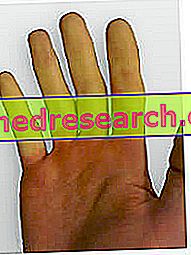Generality
Raynaud's phenomenon is an excessive spasm of peripheral blood vessels, which causes a reduction in blood flow to the regions involved. The reaction can be triggered by cold and / or emotional stress.

Causes
Raynaud's phenomenon is usually triggered by cold exposure. Under normal circumstances, the body's reaction to low temperatures consists in smoothing out heat loss as much as possible. To achieve this, the blood vessels below the surface of the skin start to shrink and the blood is diverted from the extremities to the vital organs. The Raynaud phenomenon could, therefore, be considered as an exaggeration of the body's natural response to thermal stress (hypo).
The result of the extreme vasoconstriction is a strong decrease in the blood supply to the respective regions, which leads the tissue to hypoxia (severe oxygen deficiency, an essential gas for cellular metabolism). Recurrent episodes can cause atrophy of the skin and subcutaneous and muscular tissues. In rare cases, they can achieve ulcerations and ischemic gangrene. Probably, Raynaud's phenomenon is caused by complex alterations in the balance between the chemicals that cause vasoconstriction and those that dilate or relax the capillary walls. Other mechanisms may include hyperactivity of the sympathetic nervous system or vascular damage. Sudden emotional or psychological disturbances can also induce a vasospastic attack.
Symptoms
During the vasospastic attack, a patient can typically manifest three phases:
- Pallor: in the presence of low temperatures, the flow of blood to the fingers or toes is markedly reduced, the skin becomes pale or white, cold and numb;
- Cyanosis: when oxygen is deficient or depleted, the affected area starts to become bluish;
- Redness: when the episode subsides or the area is heated, the skin takes on a bright red color, due to the compensatory increase in blood flow. The return of normal spraying can cause tingling, numbness and pain.
In most cases, Raynaud's phenomenon can interfere with patients' daily activities, but does not cause any long-term damage to the extremities. Attacks can last from less than a minute to several hours. After heating, it usually takes 15 minutes to restore normal blood flow to the affected area.
Primary Raynaud's phenomenon
The primary Raynaud phenomenon, also known as Raynaud's disease, does not depend on any other medical condition or problem. The condition can persist for a long time or improve spontaneously. Smoking worsens the frequency and intensity of vasospastic attacks.
Secondary Raynaud's phenomenon
In the secondary Raynaud phenomenon it is possible to identify an underlying cause or pathology. In particular, the condition occurs in approximately 85-95% of patients with scleroderma and is present in about one third of patients with systemic lupus erythematosus.
Causes
Causes of the secondary Raynaud's phenomenon
The most common causes of the secondary Raynaud phenomenon are:
Connective tissue diseases
Secondary Raynaud's phenomenon is particularly common in people with connective tissue diseases. The pathology that most likely causes Raynaud's phenomenon is systemic sclerosis (also known as scleroderma), which can also occur in a localized form called the CREST syndrome. The hallmark of the condition is the thickening of the skin, especially on the hands and face. In these areas, dilation of blood vessels (telangiectasias) and deposits of calcium salts under the skin (calcinosis) may appear. In severe forms of scleroderma, patients may develop persistent ulcers on the fingertips and infections, which in extreme cases can develop into gangrene.
Raynaud's phenomenon can also occur in patients with other connective tissue diseases, including Sjögren's syndrome, dermatomyositis, polymyositis and Wegener's granulomatosis. It is important to stress that the underlying connective tissue disease may not be evident until the manifestation of Raynaud's phenomenon.
drugs
Raynaud's phenomenon may represent a side effect of some drugs, such as:
- Amphetamines;
- Some types of beta-blockers (used mainly for angina and hypertension);
- Some chemotherapeutic agents (vinblastine, bleomycin etc.);
- Some migraine drugs containing ergotamine;
- Clonidine (due to high blood pressure, migraine or hot flushes);
- Bromocriptine (used in the management of Parkinson's disease and some other conditions);
- Imipramine (for depression);
- Oral contraceptive pill.
Once the responsible drug has been eliminated and replaced, Raynaud's phenomenon can be resolved fairly quickly.
arterial Disease
Raynaud's phenomenon can sometimes indicate the underlying atherosclerosis, especially in smokers. Buerger's disease can also determine the onset of the disorder.
Nervous disorders
Raynaud's phenomenon may develop in a limb affected by a stroke or may occur in association with multiple sclerosis and poliomyelitis.
Various
Other possible causes of the secondary Raynaud phenomenon are:
- Occupation : the professional use of vibrating instruments, such as pneumatic hammers or chainsaws, similar to repetitive blows with heavy hand tools, can cause traumatic vasospasm (known as hand-arm vibration syndrome); also the chemical exposure to industrial processes of polymerization of vinyl chloride (plastic materials) can induce a disease similar to scleroderma, of which the Raynaud phenomenon can be a manifestation.
- Carpal tunnel syndrome : the hand in question can become more sensitive to low temperatures and manifest Raynaud's phenomenon.
- Upper thoracic outlet syndrome ( TOS ).
- Some disorders of the thyroid gland : some pathologies increase the viscosity of the blood and can cause the phenomenon of Raynaud.
- Injuries: injuries prior to hands or feet, such as fractures, surgery or freezing, can lead to Raynaud's phenomenon.
How to distinguish the primary Raynaud phenomenon from the secondary?
The primary Raynaud phenomenon is more common than the secondary form. Usually, the diopathic Raynaud's disease starts under 25 years of age and affects mainly women. Patients often remember a cold intolerance going back to childhood. People with secondary Raynaud's phenomenon, on the other hand, often have symptoms of an associated condition, such as joint pain, rash, muscle weakness, etc. If the onset of symptoms occurs after the age of 25, it is important to consult a doctor to rule out any underlying causes.
Diagnosis
The patient should consult a doctor for the following reasons:
- Raynaud's phenomenon, although practically harmless in its primary form, can cause discomfort and pain; Various treatments are available to help manage the extent and frequency of attacks.
- It is important to diagnose any pathology responsible for the Raynaud phenomenon already in the early stages. A complete blood count can help confirm arthritic and autoimmune conditions and indicate if the patient is at risk of developing a connective tissue disease. Other analyzes, which may help to distinguish between the two forms of Raynaud's phenomenon, include the search for anti-nucleus antibodies (ANA) and the determination of the erythrocyte sedimentation rate (VES).
- If Raynaud's phenomenon is very serious and neglected, it can cause permanent damage to the affected limbs. It should be emphasized, however, that this complication is rare.
The tests that can be performed to confirm the diagnosis are:
- Nail capillaroscopy : consists of a simple microscopic examination of the small blood vessels at the base of the nail. In the case of primary Raynaud's phenomenon, the results of this test are normal, while they are altered in patients with the secondary form. In particular, if the capillaries are dilated or abnormal, the investigation may indicate that the patient may have an underlying connective tissue disease.
- Cold stimulation test : involves immersion of the patient's hand in ice water, to provoke an episode. However, this exam does not always work, as the whole body needs to be exposed to the cold before manifesting Raynaud's phenomenon.
Based on these investigations, the physician should be able to define whether Raynaud's phenomenon is primary or secondary and, in the latter case, will be able to recommend treatment for the associated disorder.
Complications
- If an artery is completely blocked due to spasm, skin ulcers, scars or gangrene (death of tissues) may occur. This problem is found, above all, in people with arthritis or autoimmune diseases.
- Because of poor blood circulation, the fingers can become thin and tapered, with smooth and shiny skin, while the nails grow slowly and become brittle, with longitudinal ridges.
When to contact a doctor:
- The affected part of the body becomes infected or a sore develops.
- The fingers change color and the causes are not known.
- Symptoms such as fever, rashes, swollen and painful joints appear.
Treatments and drugs
There is no cure for Raynaud's phenomenon, but attacks can be managed effectively with changes in lifestyle and, in the most serious cases, with the use of drugs. Treatment depends on the severity of the condition and does not always require medical intervention. For patients with mild attacks, some practical measures, such as using hand warmers, thermal gloves and hats, can help alleviate symptoms. Drug therapy is indicated for those with severe pain and functional impairment of the affected area. Often, drugs are prescribed to patients with secondary Raynaud's phenomenon, as more severe attacks can cause ulcers and tissue damage. Any underlying disease, or predisposition to it, must be diagnosed and treated accordingly.
The general measures that can be taken to prevent attacks include:
- Smoking cessation: nicotine can further compromise circulation, narrowing blood vessels and slowing blood flow to peripheral areas;
- Avoid taking drugs that cause constriction or spasm of blood vessels;
- Avoid sudden temperature changes;
- Protect your hands and feet from getting cold by using gloves, socks and boots;
- Avoid activities or substances (eg caffeine) that can trigger an attack;
- Try to minimize stress levels: some relaxation techniques can help manage emotional or psychological disorders.
Some drugs (calcium channel blockers, alpha-blockers and vasodilators) may be useful, especially to manage the primary Raynaud phenomenon. Calcium channel blockers, such as nifedipine, work by dilating the small blood vessels, thereby increasing blood flow to the peripheries. Depending on the pattern of presentation of symptoms and response to treatment, the daily intake of nifedipine or a preventive regimen may be indicated. If necessary, the dose can be gradually increased, but it is important to monitor any side effects (common): edema of hands and feet, headache, hot flushes and dizziness. A minority of patients with intractable Raynaud's phenomenon may require a sympathectomy, which is an operation that involves the surgical removal of tissues and nerves that narrow peripheral blood vessels. However, the procedure is not without its complications and has a rather low success rate, so it must be considered only if all the other therapeutic options have failed.
Serious episodes, which result in ulceration or tissue damage, can be treated with an intravenous infusion of prostacyclin, which requires hospitalization for a few days. Other agents, which could be useful in the management of Raynaud's phenomenon, include topical nitroglycerin and losartan.
In patients with low blood pressure, therapeutic regimens can be tried including: L-arginine (oral), vitamin E, low doses of aspirin, dipyridamole, niacin and pentoxifylline. The prognosis for the Raynaud phenomenon is variable and depends on the cause and extent of vasospastic attacks.



